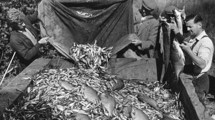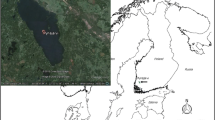Abstract
In this paper we analyze a long-term dataset on the recovery from eutrophication of Lake Veluwe (The Netherlands). Clear hysteresis was observed in a number of ecosystem variables: the route to recovery differed significantly from the route that led to loss of clear water. The macrophyte dominated state disappeared in the late 1960s at TP above 0.20 mg l−1, whereas its return occurred at less than 0.10 mg TP l−1. Several regime shifts resulting in the occurrence of three alternative stable states were observed over a period of 30 years. The turbid state showed resistance to change, despite a strong and prompt reduction in Chl-a following reduction of external P-loading. The most important component that determined hysteresis in the return to clear water was not internal P-loading, but a high level of nonalgal light attenuation (through sediment resuspension) maintained by the interaction between wind and benthivorous fish. Although Chara was able to re-colonize the most shallow parts of the lake, recovery stalled and for a number of years clear (above charophyte beds) and turbid (deeper parts of the lake) water co-existed, as a separate alternative state on route to full recovery. Lake-wide clear water was re-established after bream density had been reduced substantially. This allowed a return of zebra mussels to the lake, whose high filtration capacity helped in maintaining clear water. In this study, we were able to identify the main drivers of hysteresis and regime shifts, although formal demonstration of cause and effect was not possible on the basis of field data alone. We argue that resilience of the present clear water state of Lake Veluwe very much depends on sizable populations of a few keystone species, especially Chara (stoneworts) and Dreissena (zebra mussels), and that careful management of these species is equally important as control of nutrients. Lake management should strive to maintain and strengthen resilience of the ecosystem, and this should offer protection against a renewed collapse of the clear state.






Similar content being viewed by others
References
Bachmann RW, Hoyer MV Canfield DE. 1999. The restoration of Lake Apopka in relation to alternative stable states. Hydrobiologia 394:219–32
Bayley SE, Prather CM. 2003. Do wetland lakes exhibit alternative stable states? Submersed aquatic vegetation and chlorophyll in western boreal shallow lakes. Limnol Oceanograph 48:2335–45
Berger C. 1975. Occurrence of Oscillatoria agardhii Gom. in some shallow eutrophic lakes. Verhandlungen Internationale Vereinigung Limnologie 19:2689–97
Berger C, 1987. Habitat en ecologie van Oscillatoria agardhii Gomont. PhD Thesis University of Groningen.233 pp. ISBN 90–369–1025–0
Blindow I, Hargeby A, Andersson G. 2002. Seasonal changes of mechanisms maintaining clear water in a shallow lake with abundant Chara vegetation. Aquat Bot 72:315–34
Coops H, Doef RW. 1996. Submerged vegetation development in two shallow lakes. Hydrobiologia 340:115–20
Dent CL, Cumming GS, Carpenter SR. 2002. Multiple states in river and lake ecosystems. Philosophical Trans R Soc Lond Series B-Biol Sci 357:635–45
Dionisio Pires LM, Van Donk E. 2002. Comparing grazing by Dreissena polymorpha on phytoplankton in the presence of toxic and non-toxic cyanobacteria. Freshwater Biol 47:1855–65
Dionisio Pires LM, Ibelings BW, Brehm M, Van Donk E. 2005. Comparing grazing on lake seston by Dreissena and Daphnia: lessons for biomanipulation. Microb Ecol 50:242–252
Dokulil MT, Teubner K. 2003. Eutrophication and restoration of shallow lakes - the concept of stable equilibria revisited. Hydrobiologia 506:29–35
Gonzalez SMA, Jeppesen E, Goma J, Sondergaard M, Jensen JP, Lauridsen T, Landkildehus F. 2005. Does high nitrogen loading prevent clear water conditions in shallow lakes at moderately high phosphorous concentrations? Freshwater Biol 50:27–41
Griffiths RW. 1992. Effects of zebra mussels (Dreissena polymorpha) on the benthic fauna of Lake St. Clair. In: Nalepa DW, ed. Zebra mussels—biology, impacts and control. Lewis Publishers. pp 415–37
Gunderson LH. 2000. Ecological resilience - in theory and application. Ann Rev Ecol Syst 31:425–39
Havens KE, Aumen NG. 2000. Hypothesis driven experimental research is necessary for natural resource management. Environ Manag 25:1–7
Holling CS. 1973. Resilience and stability of ecological systems. Ann Rev Ecol Syst 4:1–23
Hosper SH. 1997. Clearing lakes. An ecosystem approach to the restoration and management of shallow lakes in the Netherlands. RIZA (Lelystad). 168 pp. ISBN 90–5485–682–3
Jackson LJ. 2003. Macrophyte-dominated and turbid states of shallow lakes: evidence from Alberta Lakes. Ecosystems 6:213–23
Jagtman E, Van der Molen DT, Vermij S. 1992. The influence of flushing on nutrient dynamics, composition and densities of algae and transparency in Veluwemeer, The Netherlands. Hydrobiologia 233:187–96
Jeppesen EJP, Jensen M, Sondergaard M, Lauridsen T. 1999. Trophic dynamics in turbid and clear water lakes with special emphasis on the role of zooplankton for water clarity. Hydrobiologia 409:217–31
Jeppesen E, Sondergaard M, Jensen JP, Havens KE, Anneville O, Carvalho L, Coveny MF, Deneke R, Dokulil MT, Foy B, Gerdeaux D, Hampton SE, Hilt S, Kangur K, Köhler L, Lammens EHRR, Lauridsen TL, Manca M, Miracle MR, Moss B, Nõges P, Persson G, Phillips G, Portielje R, Romo S, Schelske CL, Straile D, Tatrai, Willen E, Winder M. 2005. Lake responses to nutrient loading–an analysis of contemporary long-term data from 35 case studies. Freshwater Biol 50:1747–1771
Korner S. 2001. Development of submerged macrophytes in shallow Lake Muggelsee (Berlin, Germany) before and after its switch to the phytoplankton-dominated state. Archiv Fur Hydrobiologie 152:395–409
Lammens EHRR, Van Nes EH, Mooij WM. 2002. Differences in the exploitation of bream in three shallow lake systems and their relation to water quality. Freshwater Biol 47:2435–42
Lammens EHRR, Van Nes EH, Meijer ML, Van den Berg MS. 2004. Effects of commercial fishery on the bream population and the expansion of Chara aspera in Lake Veluwe. Ecol Modell 177:233–44
Leentvaar P. 1961. Hydrobiologische waarnemingen in het Veluwemeer. De Levende Natuur 64: 273–9
Lowe EF, Battoe LE, Coveny LF, Schelske CL, Havens KE, Marzolf ER, Reddy KR. 2001. The restoration of Lake Apopka in relation to alternative stable states: an alternative view to that of Bachmann and others (1999). Hydrobiologia 448:11–8
Meijer ML, Hosper SH. 1997. Effects of biomanipulation in the large and shallow lake Wolderwijd. Hydrobiologia 342/343:335–49
Meijer ML, De Boois I, Scheffer M, Portielje R., Hosper H. 1999. Biomanipulation in shallow lakes in the Netherlands: an evaluation of 18 case studies. Hydrobiologia 409:13–30
Moss B, Stansfield J, Irvine K, Perrow M, Phillips G. 1996. Progressive restoration of a shallow lake: A 12-year experiment in isolation, sediment removal and biomanipulation. J Appl Ecol 33:71–86
Mur LR, Gons HJ, Van Liere L. 1978. Competition of the green alga Scenedesmus and the blue-green alga Oscillatoria. Miiteilungen Internatnationale Vereins Limnologie 21:473–9
Murphy J, Riley JP. 1962. A modified single solution method for the determination of phosphate in natural waters. Analytica Chimica Acta 27:31–6
Noordhuis R, Van der Molen DT, Van der Berg MS. 2002. Response of herbivorous water-birds to the return of Chara in Lake Veluwemeer, the Netherlands. Aquat Bot 72: 349–67
Portielje R, Rijsdijk RE. 2003. Stochastic modeling of nutrient loading and lake ecosystem response in relation to submerged macrophytes and benthivorous fish. Freshwater Biol 48:741–55
Portielje R, Van der Molen DT. 1999. Relationships between eutrophication variables: from nutrient loading to transparency. Hydrobiologia 409:375–87
Reeders HHP, Boers PCM, Van der Molen DT, Helmerhorst TH. 1998. Cyanobacterial dominance in the lakes Veluwemeer and Wolderwijd, The Netherlands. Water Sci Technol 37:85–92
Reynolds CS. 1997. Vegetation processes in the pelagic: a model for ecosystem theory. Ecology Institute (Oldedorf). 371 p
Sarnelle O, Wilson AE, Hamilton SK, Knoll LB, Raikow DF. 2005. Complex interactions between the zebra mussel, Dreissena polymorpha, and the harmful phytoplankter, Microcystis aeruginosa. Limnol Ocenaograph 50:896–904
Scheffer M.1998. Ecology of shallow lakes. Chapman & Hall London pp 357
Scheffer M, Carpenter SR. 2003. Catastrophic regime shifts in ecosystems: linking theory to observation. Trends Ecol Evol 18:648–56
Scheffer M. Van den Berg M, Breukelaar A, Coops H., Doef R., Meijer ML. 1994. Vegetated areas with clear water in turbid shallow lakes. Aquat Bot 49:193–6
Scheffer M, Rinaldi S, Gragnali A, Mur LR, Van Nes EH. 1997. On the dominance of filamentous cyanobacteria in shallow, turbid lakes. Ecology 78: 272–82
Scheffer M, Carpenter SR, Foley JA, Folke C, Walker B. 2001. Catastrophic shifts in ecosystems. Nature 413: 591–596
Scheffer M, Portielje R, Zambrano L. 2003. Fish facilitate wave resuspension of sediment. Limnol Oceanograph 48:1920–6
Schriver P, Bogestand J, Jeppesen E, Sondergaard M. 1995. Impact of submerged macrophytes on fish-zooplankton-phytoplankton interactions - large-scale enclosure experiments in a shallow eutrophic lake. Freshwater Biol 33:255–70
Sokal RR, Rohlf FJ. 1995. Biometry: the principles and practice of statistics in biological research. 3rd edn. New York: W. H. Freeman and Co. pp 887 ISBN: 0–7167–2411-1
Sondergaard M, Jensen JP, Jeppesen E. 2003. Role of sediment and internal loading of phosphorus in shallow lakes. Hydrobiologia 506:135–145
Suding KN, Gross KL, Houseman GR. 2004. Alternative states and positive feedbacks in restoration ecology. Trends Ecol Evol 19:46–53
Van Den Berg M, Scheffer M, Coops H, Simons J. 1998. The role of Characean algae in the management of eutrophic shallow lakes. J Phycol 34:750–6
Van Den Berg MS, Scheffer M, Van Nes EH, Coops H. 1999. Dynamics and stability of Chara sp and Potamogeton pectinatus in a shallow lake changing in eutrophication level. Hydrobiologia 409:335–42
Van Den Berg M, Coops H., Simons J. 2001. Propagule bank buildup of Chara aspera and its significance for colonization of a shallow lake. Hydrobiologia 462:9–17
Van Der Molen DT, Portielje R, Boers PCM, Lijklema L. 1998. Changes in sediment phosphorus as a result of eutrophication and oligotrophication in Lake Veluwe, The Netherlands. Water Res 32:3281–88
Van Der Molen DT, Portielje R. 1999. Multi-lake studies in The Netherlands: trends in eutrophication. Hydrobiologia 409:359–65
Van Donk E, Van De Bund WJ. 2002. Impact of submerged macrophytes including charophytes on phyto- and zooplankton communities: allelopathy versus other mechanisms. Aquat Bot 72:261–74
Verdugt N. 1981. De gevolgen van de aflsuiting van de Zuiderzee en de inpoldering van Flevoland voor de waterkwaliteit in het IJsselmeergebied. Rapport 1981–305. Rijksdienst voor de IJsselmeerpolders
Acknowledgments
The work presented here was supported financially through the years by The Dutch Ministry of Transport, Public Works and Water Management. We gratefully acknowledge Prof. Erik Jeppesen, Prof. Karl Havens, an anonymous reviewer and Dr. Miguel Dioniso Pires for their constructive comments on an earlier version of the manuscript.
Author information
Authors and Affiliations
Corresponding author
Rights and permissions
About this article
Cite this article
Ibelings, B.W., Portielje, R., Lammens, E.H.R.R. et al. Resilience of Alternative Stable States during the Recovery of Shallow Lakes from Eutrophication: Lake Veluwe as a Case Study. Ecosystems 10, 4–16 (2007). https://doi.org/10.1007/s10021-006-9009-4
Received:
Accepted:
Published:
Issue Date:
DOI: https://doi.org/10.1007/s10021-006-9009-4




